Effect of Secondary Vortex Flow Near Contact Point on Thermal Performance in the Plate Heat Exchanger with Different Corrugation Profiles
Abstract
1. Introduction
2. Numerical Simulation
2.1. Mathematical Representations
2.2. Computational Domain and Boundary Conditions
2.3. Performance of Plate Heat Exchanger
3. Results and Discussion
4. Conclusions
Author Contributions
Funding
Conflicts of Interest
References
- Thulukkanam, K. Heat Exchanger Design Handbook; Taylor & Francis: Boca Raton, FL, USA, 2013. [Google Scholar]
- Muley, A.; Manglik, R.M. Experimental Investigation of Heat Transfer Enhancement in a PHE With 60 Chevron Plates. Heat Mass Transf. 1995, 95, 737–744. [Google Scholar]
- Abou Elmaaty, T.M.; Kabeel, A.E.; Mahgoub, M. Corrugated plate heat exchanger review. Renew. Sustain. Energy Rev. 2017, 70, 852–860. [Google Scholar] [CrossRef]
- Shah, R.K.; Sekulic, D.P. Fundamentals of Heat Exchanger Design; Wiley: Hoboken, NJ, USA, 2003. [Google Scholar]
- Tohidi, A.; Hosseinalipour, S.M.; Taheri, P.; Nouri, N.M.; Mujumdar, A.S. Chaotic advection induced heat transfer enhancement in a chevron-type plate heat exchanger. Heat Mass Transf. 2013, 49, 1535–1548. [Google Scholar] [CrossRef]
- Brenk, A.; Pluszka, P.; Malecha, Z. Numerical study of flow maldistribution in multi-plate heat exchangers based on robust 2D model. Energies 2018, 11, 3121. [Google Scholar] [CrossRef]
- Focke, W.W.; Knibbe, P.G. Flow Visualization in Parallel-Plate Ducts with Corrugated Walls. J. Fluid Mech. 1986, 165, 73–77. [Google Scholar] [CrossRef]
- Gherasim, I.; Taws, M.; Galanis, N.; Nguyen, C.T. Heat transfer and fluid flow in a plate heat exchanger part I. Experimental investigation. Int. J. Therm. Sci. 2011, 50, 1492–1498. [Google Scholar] [CrossRef]
- Gherasim, I.; Galanis, N.; Nguyen, C.T. Heat transfer and fluid flow in a plate heat exchanger. Part II: Assessment of laminar and two-equation turbulent models. Int. J. Therm. Sci. 2011, 50, 1499–1511. [Google Scholar] [CrossRef]
- Tsai, Y.C.; Liu, F.B.; Shen, P.T. Investigations of the pressure drop and flow distribution in a chevron-type plate heat exchanger. Int. Commun. Heat Mass Transf. 2009, 36, 574–578. [Google Scholar] [CrossRef]
- Hayes, N.; Jokar, A.; Ayub, Z.H. Study of carbon dioxide condensation in chevron plate exchangers; pressure drop analysis. Int. J. Heat Mass Transf. 2012, 55, 2916–2925. [Google Scholar] [CrossRef]
- Gullapalli, V.S.; Sundén, B. CFD Simulation of Heat Transfer and Pressure Drop in Compact Brazed Plate Heat Exchangers. Heat Transf. Eng. 2013, 35, 358–366. [Google Scholar] [CrossRef]
- Muley, A.; Manglik, R.M. Enhanced heat transfer characteristics of single-phase flows in a plate heat exchangers with mixed chevron plates. J. Enhanc. Heat Transf. 1997, 4, 187–201. [Google Scholar] [CrossRef]
- Lee, J.; Lee, K.S. Flow characteristics and thermal performance in chevron type plate heat exchangers. Int. J. Heat Mass Transf. 2014, 78, 699–706. [Google Scholar] [CrossRef]
- Lee, J.; Lee, K.S. Friction and Colburn factor correlations and shape optimization of chevron-type plate heat exchangers. Appl. Therm. Eng. 2015, 89, 62–69. [Google Scholar] [CrossRef]
- Kanaris, A.G.; Mouza, A.A.; Paras, S.V. Flow and heat transfer prediction in a corrugated plate heat exchanger using CFD code. Chem. Eng. Technol. 2006, 29, 923–930. [Google Scholar] [CrossRef]
- Liu, X.P.; Niu, J.L. Effects of geometrical parameters on the thermohydraulic characteristics of periodic cross-corrugated channels. Int. J. Heat Mass Transf. 2015, 84, 542–549. [Google Scholar] [CrossRef]
- Zhang, L.; Che, D.F. Influence of Corrugation Profile on the Thermalhydraulic Performance of Cross-Corrugated Plates. Numer. Heat Transf. Part A Appl. 2011, 59, 267–296. [Google Scholar] [CrossRef]
- Focke, W.W. Asymmetrically Corrugated Plate Heat-Exchanger Plates. Int. Commun. Heat Mass Transf. 1985, 12, 67–77. [Google Scholar] [CrossRef]
- Luan, H.B.; Kuang, J.P.; Cao, Z.; Wu, Z.; Tao, W.Q.; Sunden, B. CFD analysis of two types of welded plate heat exchangers. Numer. Heat Transf. Part A Appl. 2017, 71, 250–269. [Google Scholar] [CrossRef]
- Fluent Inc. Fluent 17.0 User’s Manual; Fluent Inc.: Canonsburg, PA, USA, 2016. [Google Scholar]
- Kakaç, S.; Liu, H.; Pramuanjaroenkij, A. Heat Exchangers: Selection, Rating, and Thermal Design; Taylor & Francis: Boca Raton, FL, USA, 2012. [Google Scholar]
- Incropera, F.P.; DeWitt, D.P.; Bergman, T.L.; Lavine, A. Principles of Heat and Mass Transfer; John Wiley & Sons: Hoboken, NJ, USA, 2003. [Google Scholar]
- Lee, H.; Ryu, J.; Lee, S. Influence of Perforated Fin on Flow Characteristics and Thermal Performance in Spiral Finned-Tube Heat Exchanger. Energies 2019, 12, 556. [Google Scholar] [CrossRef]
- Lee, J.; Lee, H.J.; Ryu, J.; Lee, S.H. Three-dimensional turbulent flow and heat transfer characteristics of longitudinal vortices embedded in turbulent boundary layer in bent channels. Int. J. Heat Mass Transf. 2018, 117, 958–965. [Google Scholar] [CrossRef]
- Blomerius, H.; Holsken, C.; Mitra, N.K. Numerical investigation of flow field and heat transfer in cross-corrugated ducts. J. Heat Transf. 1999, 121, 314–321. [Google Scholar] [CrossRef]
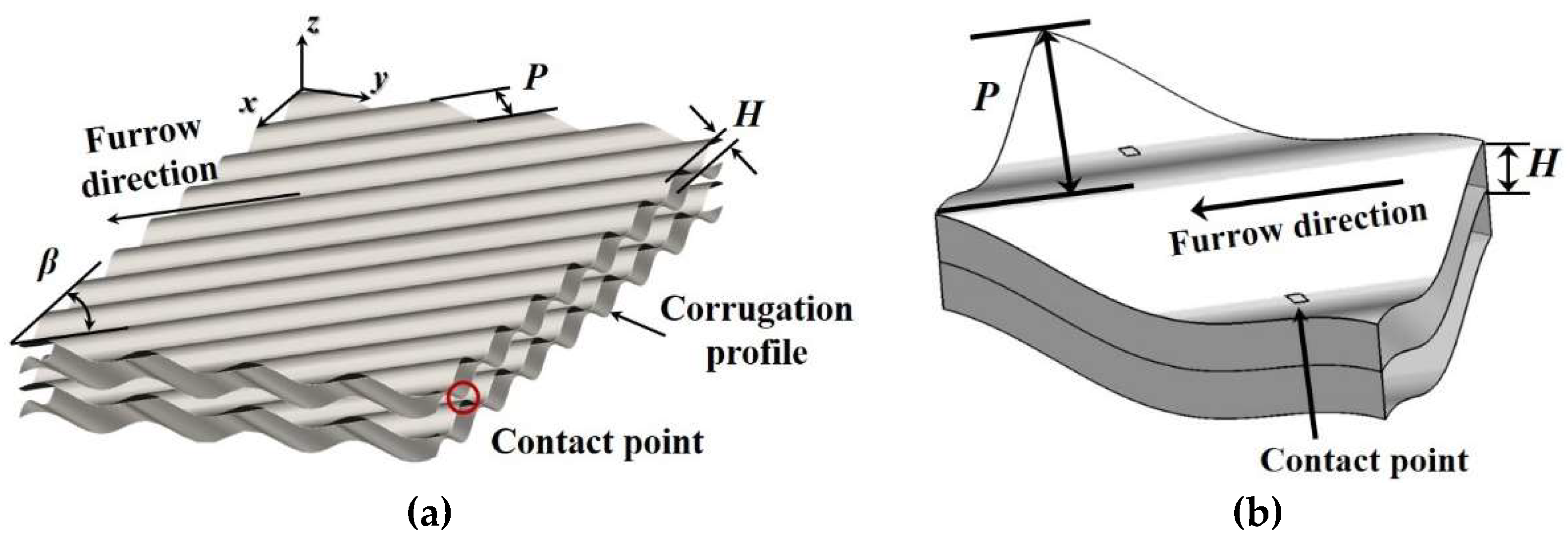
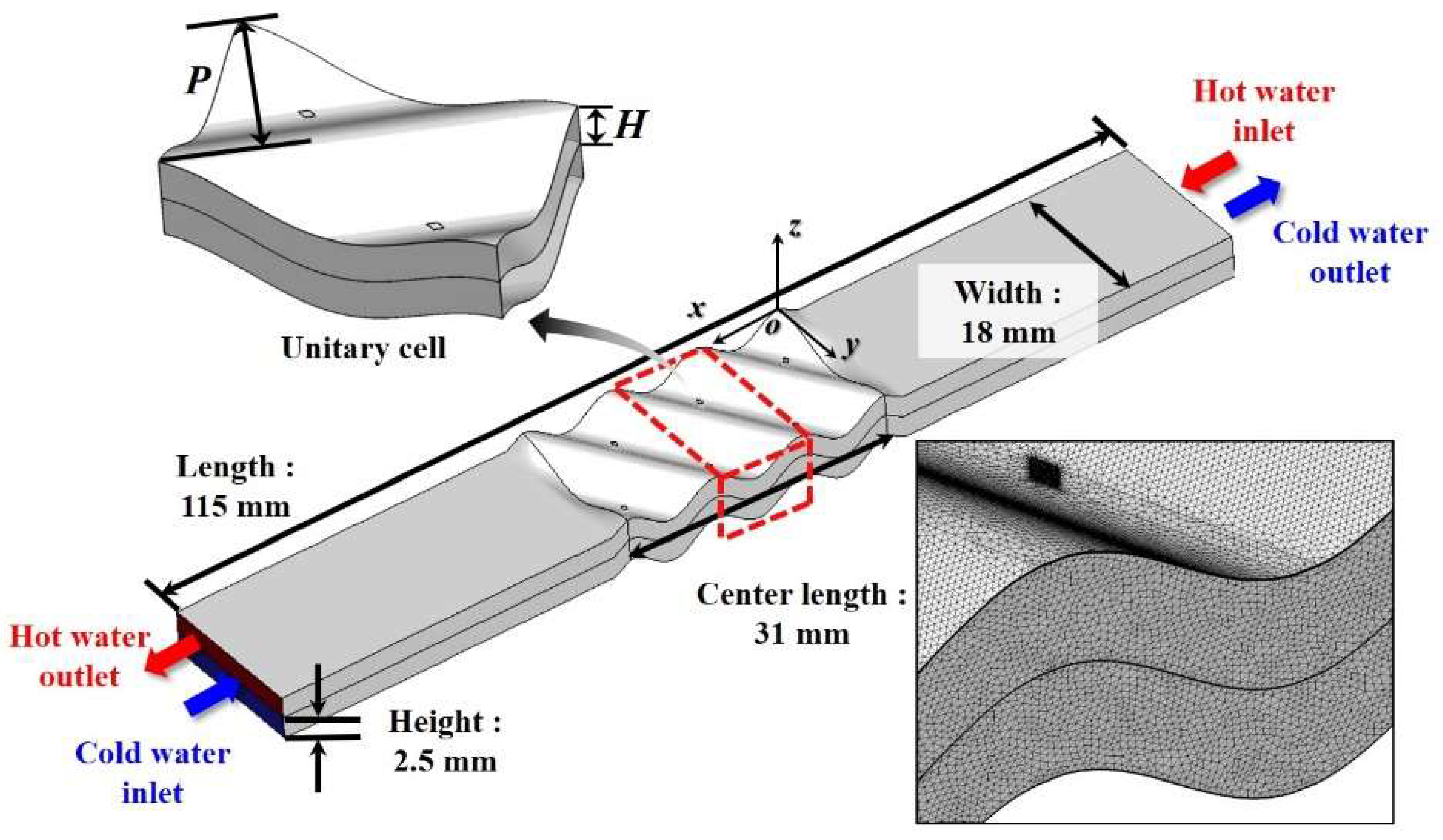

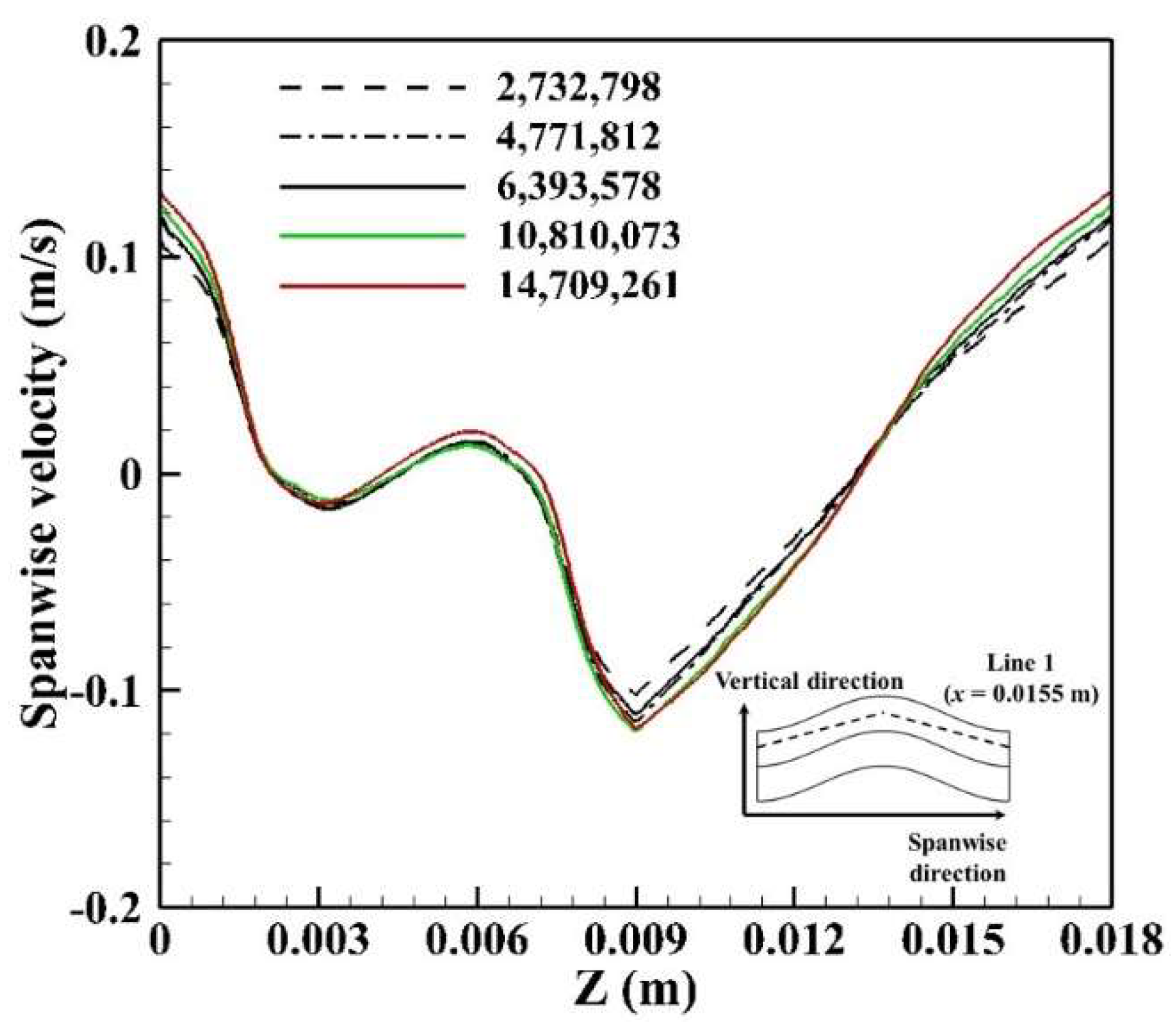
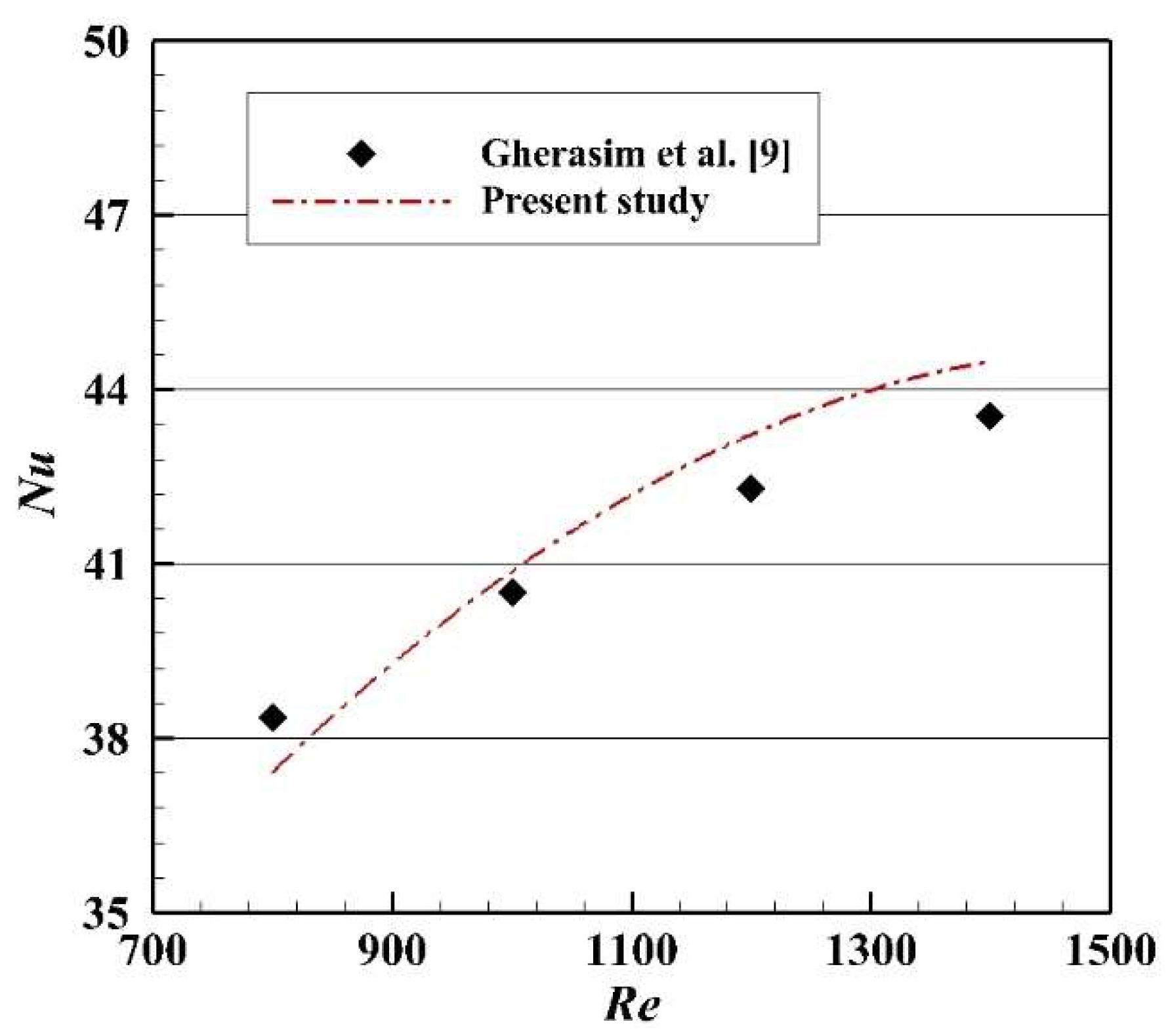
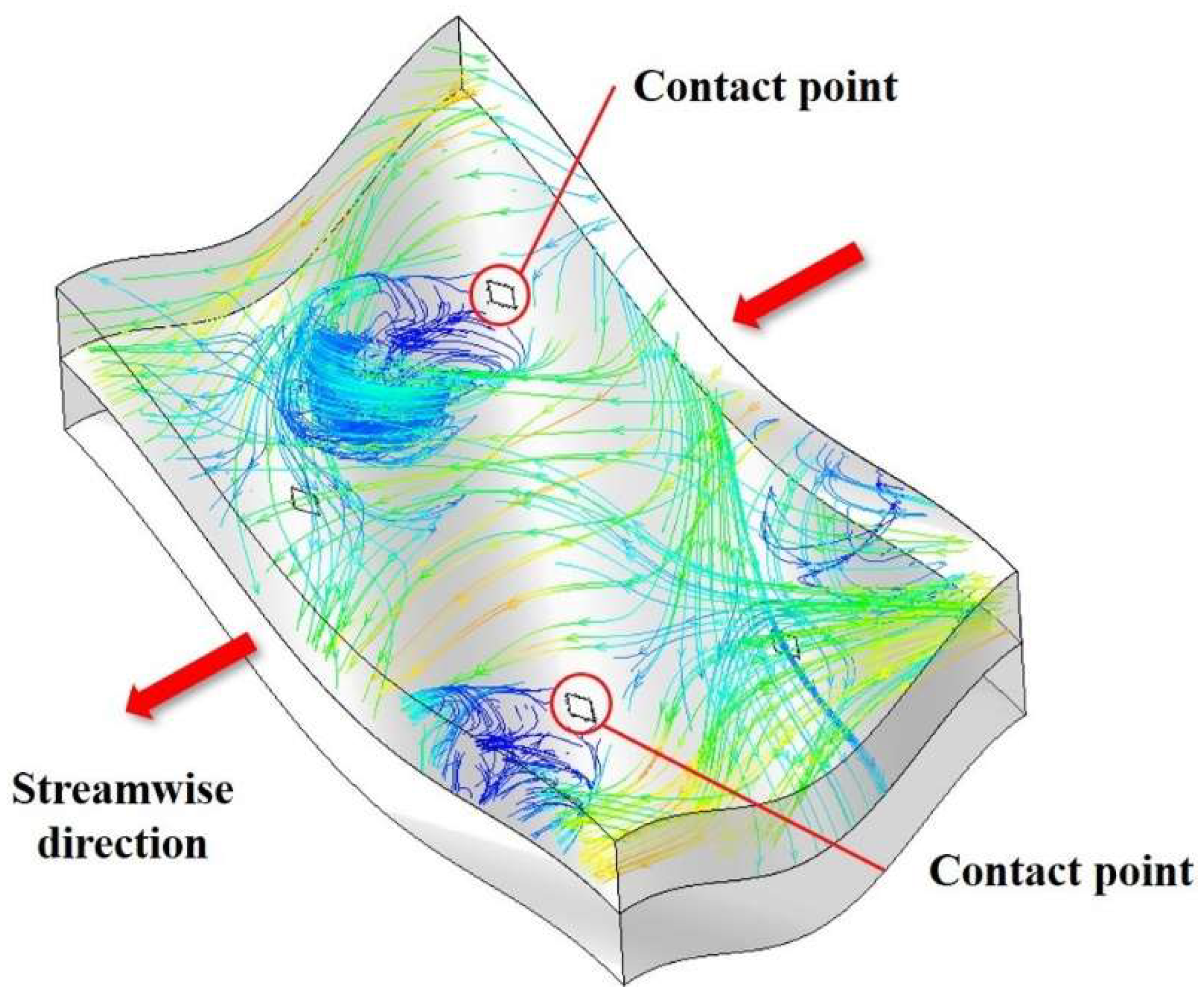
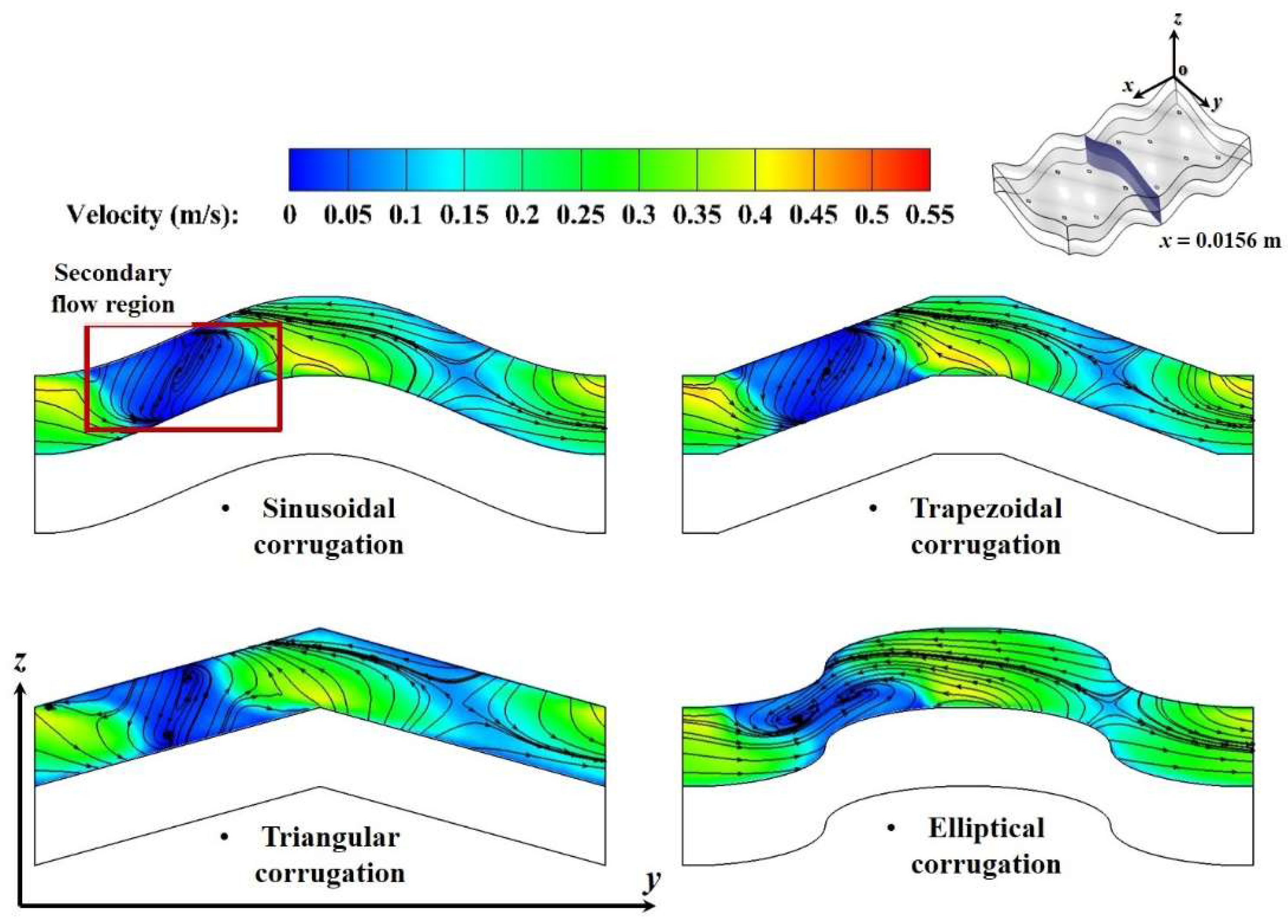

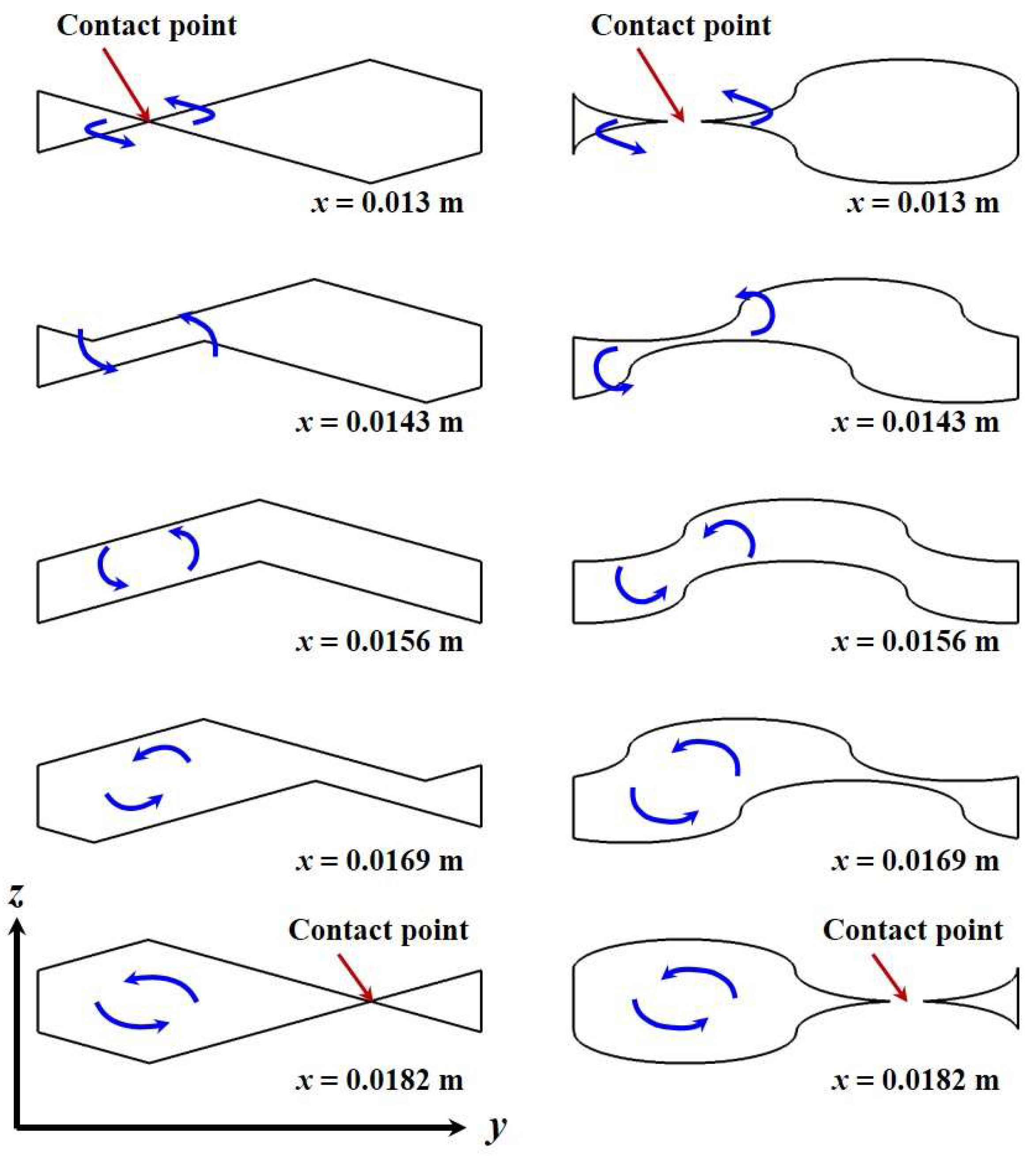


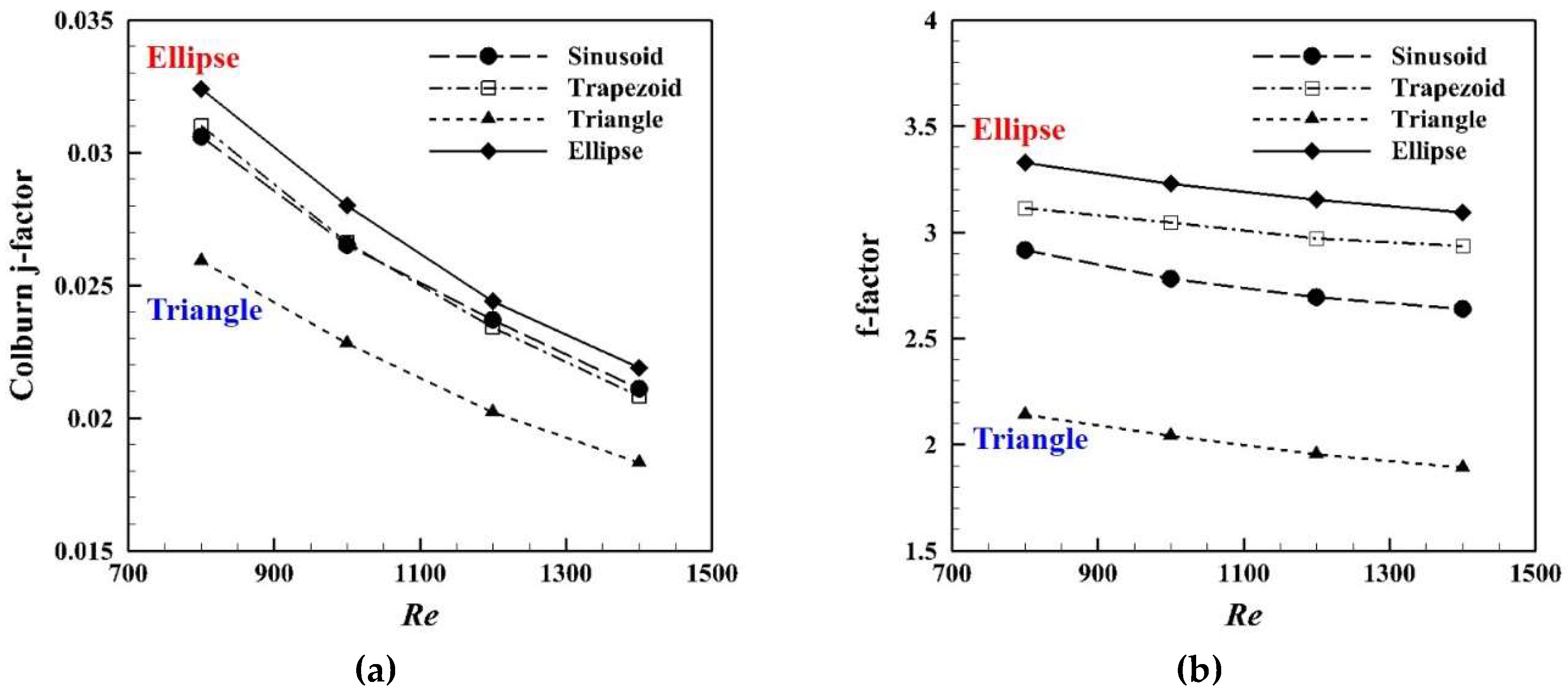
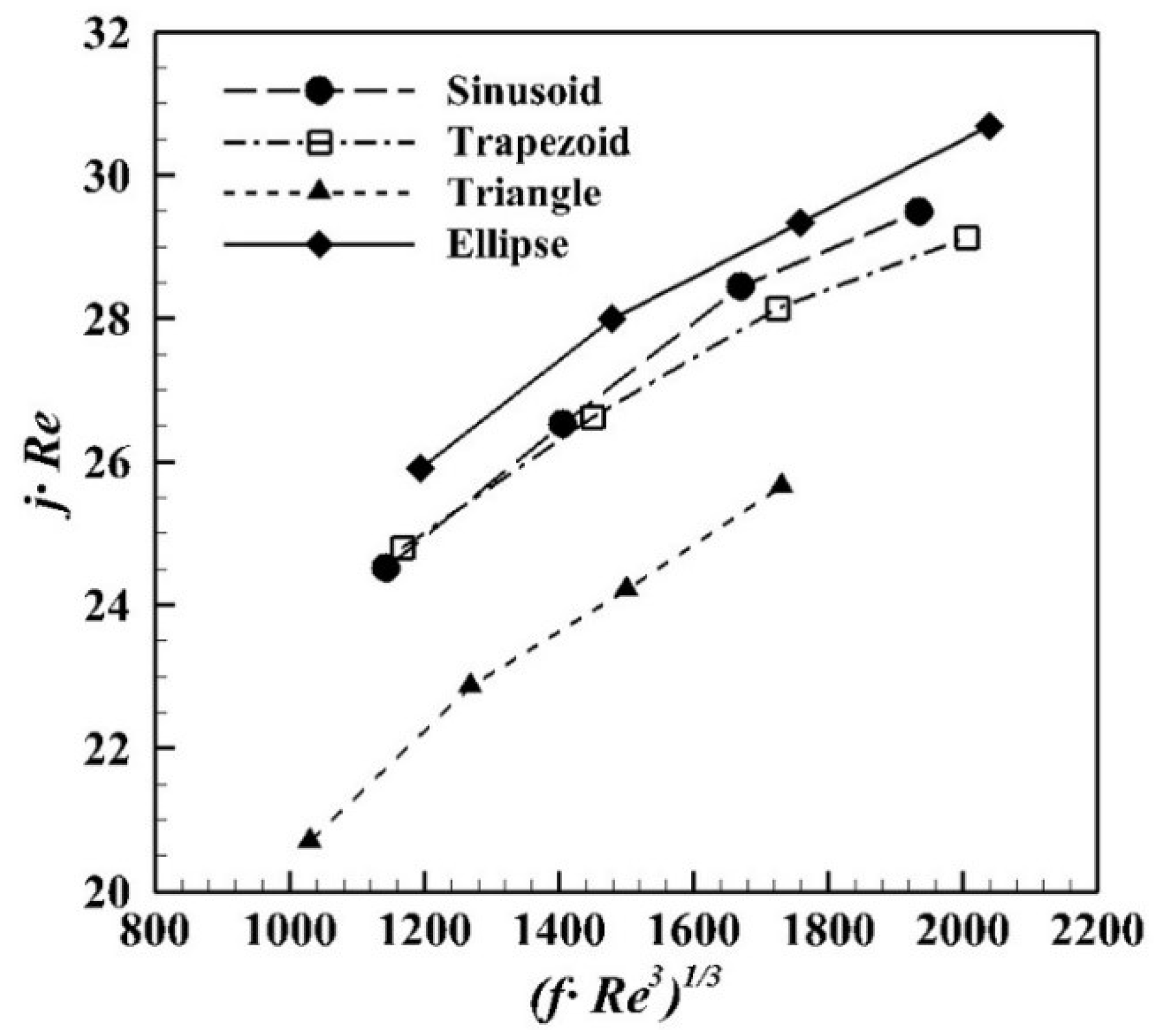
| Component | Stainless Steel |
|---|---|
| Density, ρs | 8030 kg/m3 |
| Thermal conductivity, ks | 16.27 W/m∙K |
| Specific heat at constant pressure, Cp,s | 502.48 J/kg∙K |
© 2020 by the authors. Licensee MDPI, Basel, Switzerland. This article is an open access article distributed under the terms and conditions of the Creative Commons Attribution (CC BY) license (http://creativecommons.org/licenses/by/4.0/).
Share and Cite
Lee, H.J.; Lee, S.H. Effect of Secondary Vortex Flow Near Contact Point on Thermal Performance in the Plate Heat Exchanger with Different Corrugation Profiles. Energies 2020, 13, 1328. https://doi.org/10.3390/en13061328
Lee HJ, Lee SH. Effect of Secondary Vortex Flow Near Contact Point on Thermal Performance in the Plate Heat Exchanger with Different Corrugation Profiles. Energies. 2020; 13(6):1328. https://doi.org/10.3390/en13061328
Chicago/Turabian StyleLee, Hyung Ju, and Seong Hyuk Lee. 2020. "Effect of Secondary Vortex Flow Near Contact Point on Thermal Performance in the Plate Heat Exchanger with Different Corrugation Profiles" Energies 13, no. 6: 1328. https://doi.org/10.3390/en13061328
APA StyleLee, H. J., & Lee, S. H. (2020). Effect of Secondary Vortex Flow Near Contact Point on Thermal Performance in the Plate Heat Exchanger with Different Corrugation Profiles. Energies, 13(6), 1328. https://doi.org/10.3390/en13061328




